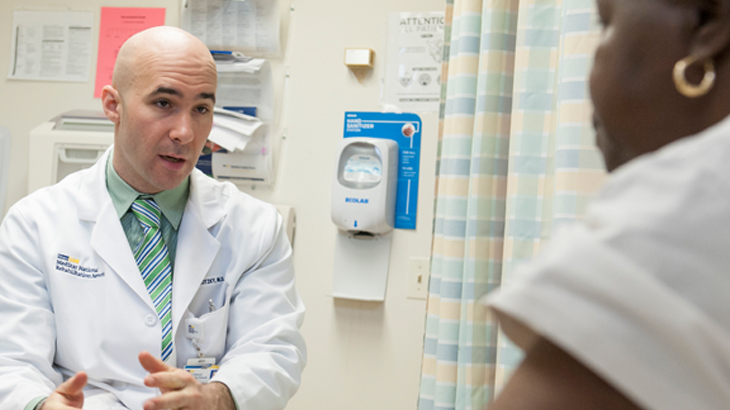
Head and neck cancer is the term used to identify a number of malignancies, including cancer of the mouth, nose, throat, and salivary glands. Treatment will vary from individual to individual and may include surgery, chemotherapy and radiation therapy, alone or in combination.
Rehabilitation is a critical part of recovery, as most patients suffer from a number of conditions resulting from the disease process that ultimately impact their day-to-day functioning. At MedStar National Rehabilitation Network (MedStar NRH), a team of rehabilitation experts works collaboratively to help patients cope with these medical issues.
The MedStar NRH team brings together the expertise of rehabilitation physicians, physical therapists, and speech-language pathologists — all who have extensive experience in cancer rehabilitation. The team works hand-in-hand with surgeons, otolaryngologists, radiation oncologists, medical oncologists, and patients to develop a plan of care to help manage or prevent side effects.
Common medical issues
Radiation therapy is the most common form of treatment for head and neck cancer — and a major source of medical complications. While it may prove effective in destroying cancer cells, it can also damage healthy cells in the treatment area. Many patients develop scarring in the area of radiation, called radiation fibrosis, that results in the thickening of skin — and tightness of muscles.
Surgery to remove cancerous tissue and chemotherapy to kill cancer cells can result in difficult side effects, as well.
Common complications include:
- Altered texture of the skin
- Trismus — difficulty opening the jaw
- TMJ — Temporomandibular joint dysfunction that can cause pain when the jaw is opened
- Xerostomia — dryness in the mouth
- Dysphagia — problems chewing or swallowing due to muscle weakness or changes in structures of the face, mouth, and pharynx after surgery
- Dysarthria — difficulty speaking clearly due to muscle weakness or changes in the structures of the face, mouth, and pharynx after surgery
- Dysgeusia — reduced or altered sense of taste
- Mucositis — painful inflammation and ulceration in the lining the mouth or digestive tract
- Cervical dystonia — neck muscle spasms, pain, or posture change
- Lymphedema — swelling in the face or neck
- Headaches and migraines
- Posture abnormalities, shoulder problems
- Cancer-related fatigue
- Cognitive challenges, such as reduced attention or mental sharpness, as a result of chemotherapy
- Neuropathy — chemotherapy-induced nerve pain, tingling, numbness, or impaired balance
Personalized assessment
The hallmark of the program is its interdisciplinary framework that begins with a comprehensive medical evaluation. Our team of cancer rehabilitation specialists come together using state-of-the-art evaluation techniques to assess the multifaceted medical issues that are the hallmark of head and neck cancer. Then the team integrates evaluation findings to develop innovative treatment plans for their clients.
Medical interventions
Our physicians will typically prescribe a comprehensive rehabilitation program of physical and/or speech therapy designed to address the primary problems that are impeding patients’ ability to perform daily tasks.
In addition, our physicians may prescribe:
- Rehabilitation equipment to enhance function
- Oral or topical medications to decrease pain and/or spasms
- Injections for musculoskeletal pain or spasm, such as anesthetic, corticosteroid, or botulinum toxin
Physical therapy
A number of physical therapy techniques will be employed depending on a patient’s unique functional problems. These may include:
- Manual therapy and techniques to relax tissue, increase range of motion, and decrease pain
- Therapeutic exercise to improve strength in the jaw, cervical spine and shoulder, increase range of motion, and improve posture
- Lymphedema management including lymphatic massage, exercises, patient education, and compression garment recommendations
- Techniques to improve soft tissue mobility for range of motion and communication in patients with TMJ
- Pain management, including electrical stimulation and gentle neck traction to minimize pain at the surgical site and surrounding structures
- Aquatic therapy in a heated pool to assist with range of motion, stretches, and pain management
Communication, swallowing, and cognition
For patients suffering from issues related to communication and swallowing, speech-language pathologists will develop a plan of therapy that may include:
- Techniques to help patients produce speech more clearly, naturally, and confidently
- Strategies to promote safe swallowing of liquids, food, and medication
- Exercises to increase range of motion and decrease pain
- Use of a splinting device to reduce pain and increase mobility
- Use of augmentative and alternative modes of communication, such as an electrolarynx, electronic devices, or other aids
- Methods to manage concerns about memory or other thinking skills
Our providers

Expert rehabilitation care
Getting the care you need starts with seeing one of our rehabilitation care specialists.









